Buddhism in Thailand
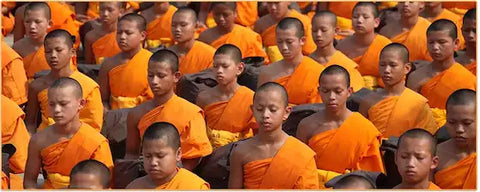
From spirit houses to temples and beyond, it's clear that the national religion, Theravada Buddhism, is important to Thais. This religion influences the daily lives of both Thais and tourists in many ways. To better understand the people and their beliefs, here's everything you need to know about Buddhism in Thailand.
See our collection of Buddhist Statues
The arrival of Buddhism in Thailand
Buddhism originated in India in the 6th century BCE, founded by Prince Siddhartha , who ultimately attained the ultimate goal of enlightenment. After 49 days of meditation under a bodhi tree , he became the Buddha, or "the Awakened One." Buddhism then spread to Thailand from Sri Lanka. It became the dominant religion in Thailand and Laos by the 12th century.
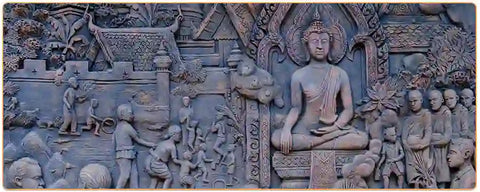
Buddhism in Thailand
The official religion in Thailand is Theravada Buddhism , practiced by over 95% of the population and by many people from Laos, Myanmar, and Cambodia. However, Buddhism is generally considered a way of life rather than a religion by many Thais. Although it is the dominant religion in Thailand, freedom of religious choice and expression is protected by law. Small displays of this religion can be seen in even the most discreet corners of the country. Visitors will find daily reminders of Buddhism during their travels, from the imposing temples found along the Chao Phraya River to the spirit houses protecting buildings and much more throughout the country.
Buddhism is a key element of the identity of many Thais. Many make daily offerings to Buddha statues or spirit houses. By creating and acquiring merit , many Thais believe they will live longer and be happier. Laypeople can also acquire good karma . For example, a common daily routine for Thais is giving alms to monks, which in turn reflects a reciprocity between the alms-giver (who receives merit) and the monk (who receives food and can thus continue his ascetic practices ). Furthermore, it is common to find families where the son, usually the youngest, studies to become an ordained monk, as this is believed to bring merit to the family. Most Thais visit their local temple on special holidays and seek the monks' blessings for weddings, births, and funerals.
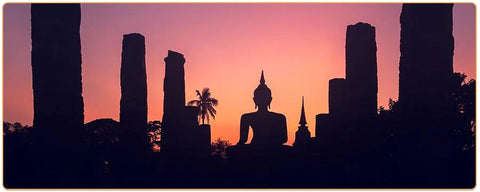
In Theravada Buddhism, the Buddha is not considered a "God" in the Abrahamic sense. Devotion to the Buddha is more akin to the respect a student has for a teacher. Veneration for the Buddha is an important principle for Buddhists in Thailand and is enshrined in law, which prohibits insulting or defacing the Buddha.
The fundamental teaching ( Dhamma ) of Buddhism is that of the " Four Noble Truths ," which states that all existence is based on suffering, from which one can be liberated by practicing the " Eightfold Path ." For many Thais, Buddhism is considered a philosophy of life, and many Buddhist principles—such as tolerance, tranquility, and merit—are values found throughout Thai culture.
An important characteristic of Buddhism in Thailand is its syncretism with other religions. Buddhism, as practiced in Thailand, borrows elements from animism and Hinduism . Notable manifestations of animism in Thai Buddhism are the spirit houses found throughout Thailand. Often resembling Buddhist temples, spirit houses are small-scale models of houses and serve as homes for the spirits associated with the site. It is common for Thais to make offerings to the spirits and ghosts they believe are present. For example, Thai houses often have spirit houses to appease spirits that were disturbed during the house's construction, and daily offerings of food and flowers are made to these spirits.
Monks in Thailand
Some 300,000 monks live in the “Land of Smiles.” From Phuket to Bangkok, tourists are almost guaranteed to see some of them in Thailand. Their yellow and orange robes are easily recognizable amidst a sea of modern clothing. Many Thais begin their day by making offerings to the monks who collect donations in the streets.
Every man in Thailand is required to become a monk for a few months before the age of 20. Although the prescribed period is about three months, some stay only a day or two. But the majority of monks remain for at least a few weeks. Young men do this to gain better karma and merit. Thais who are wealthy or have money are considered to have very good karma. Those who do not have money are considered to have behaved badly in a previous life, which is seen as evidence of bad karma .

The Sangha (the Buddhist monastic order comprising ordained monks, nuns, and/or novices) is an important institution in Thailand. Traditionally, the Sangha provides education to the population. While Buddhist educational institutions exist in contemporary society, they are generally geared towards individuals seeking to join the monastic community.
If a man decides to become a monk, he must undergo several rituals and procedures . For example, he must shave his head and eyebrows and participate in a number of ceremonies. They must also perform daily tasks in the temple where they reside, such as cleaning or receiving offerings in the morning.
Living as a monk is not easy. For one thing, there are hundreds of rules they must follow. Some are quite basic, like always wearing a robe , while others are stricter, such as abstaining from alcohol . They must also adhere to a long list of precepts when they go out in public. For example, monks cannot laugh or speak loudly.
Monks are generally very friendly, both to Thais and foreigners. Some temples offer activities like " monk chats ," where tourists can sit with a monk and talk about his life and Buddhist concepts. It's worth noting that most Thais will give up their seat on public transport for a monk. Tourists should do the same.

Buddhist festivals and celebrations
Many festivals and celebrations revolve around Thailand's main religion. One of these is called Magha Puja . It is the second most important Buddhist festival, celebrated on the full moon of the third lunar month. Monks pay homage to the Buddha, and this festival commemorates a meeting between the Buddha and 1,250 of his first disciples. Buddhists gather in temples, perform devotions, light candles , and hold processions. Furthermore, people gain merit by visiting temples and participating in the activities.
At the beginning of March, Buddhists celebrate the Wat Phra Buddha Phat festival. Many temples bear the footprints of Buddha (some natural, others artificial). The most famous of these is located at the Phra Phutthabat temple in Saraburi. The festival is a time when Buddhists come to venerate the giant footprint.
As mentioned earlier, every man in Thailand must become a monk before the age of 20. The Si Satchanalai Ordinations, held in April, celebrate this. People wear colorful costumes and participate in a parade.
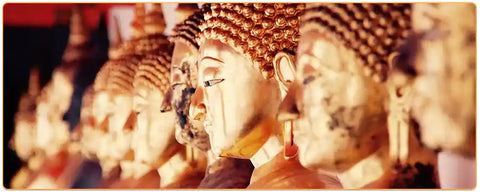
Songkran is one of the most famous Buddhist festivals, marking the Buddhist New Year. It involves a giant water fight that takes place throughout the country, symbolizing the washing away of sins and bad luck from the previous year. It originated from the practice of pouring water on Buddha statues. Many tourists participate in the activities, splashing each other with water.
Visakha Puja is one of the most important Buddhist festivals, held in early May. It commemorates the birth, death, and enlightenment of Buddha . Thai Buddhists gather with lit candles around the country's many temples. In the evenings, lively religious processions can be seen throughout Thailand.
Khao Phansa , also known as Buddhist Lent , takes place the day after the full moon of the eighth lunar month and marks the beginning of the rainy season. It is the start of a three-month period during which monks undertake a three-month retreat in their temples, dedicating themselves to study and meditation. Buddhists come to offer yellow robes and candles to the retreating monks. Colorful processions, folk dances, and performances are also common. It is also a time of abstinence during which people eat and drink in moderation.
Asalha Puja is a public holiday in Thailand. It honors the Buddha , commemorates his first sermon , and marks the founding of the Buddha's Sangha—the Four Noble Truths. It is celebrated during the full moon in July at temples throughout the country. The day is filled with offerings to temples and monks, and listening to sermons attributed to the Buddha.

The Wax Castle Festival in Sakon Nakhon , in northeastern Thailand, marks the end of Buddhist Lent on the day of the waxing moon. The highlight is a wax castle procession, where people come together to decorate the castle in Ming Muang Field. Magnificent wax castles from various temples join the procession, winding their way through the municipality. People in Isan believe the wax castle will welcome Lord Buddha, who returns from heaven to help all creatures on earth. Many festivals are held throughout Thailand on this day, including the illuminated boat procession in Nakhon Phanom , the Naga Fireballs Festival in Nong Khai, and Ok Phansa, during which new monks receive their robes.
One thing visitors should keep in mind is that during these Buddhist festivals, the consumption and sale of alcohol are not permitted throughout the country.
Buddhist temples
There are approximately 30,000 Buddhist temples in Thailand. Among the most famous temples, or wat, in the Land of Smiles are Wat Phra Kaew in Bangkok and Wat Phrathat Doi Suthep in Chiang Mai. Many Thais spend their Buddhist holidays visiting these stunning architectural wonders. In addition to being places of worship and celebration, these temples often house monks, schools, and serve as gathering places for local people.
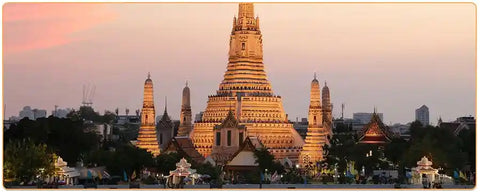
However, Buddhism in Thailand also serves to reinforce national " Thai identity ." As described above, Buddhist practices are deeply embedded in the daily routines of Thai people. Just as the image of the king permeates Thailand, Buddhist iconography is also ubiquitous. In addition to Buddhist temples and spirit houses, government buildings display images of the Buddha, and many homes feature a picture or statue of the Buddha . For the younger generation, social media has become a way to express their devotion to Buddhism. Ultimately, Buddhism in Thailand has long been intertwined with various institutions and provides a sense of stability by offering a structure upon which people can base their daily routines.

About the author: Elara Vey
Passionate about ancestral traditions and well-being practices, Elara shares her discoveries for Kaosix to help you integrate more harmony and meaning into your daily life.
Discover her journey →
